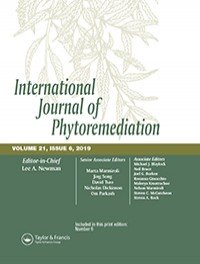International Journal of Phytoremediation Q1 Unclaimed
International Journal of Phytoremediation is a journal indexed in SJR in Plant Science and Pollution with an H index of 110. Journal with a Single blind Peer Review review system, and It has a price of 2917 €. It has an SJR impact factor of 0,656 and it has a best quartile of Q1. It is published in English. It has an SJR impact factor of 0,656.
Type: Journal
Type of Copyright:
Languages: English
Open Access Policy: Open Choice
Type of publications:
Publication frecuency: -
2917 €
Inmediate OANPD
Embargoed OA0 €
Non OAMetrics
0,656
SJR Impact factor110
H Index212
Total Docs (Last Year)467
Total Docs (3 years)13633
Total Refs1911
Total Cites (3 years)465
Citable Docs (3 years)4.18
Cites/Doc (2 years)64.31
Ref/DocOther journals with similar parameters
Annual Review of Plant Biology Q1
Fungal Diversity Q1
Molecular Plant Q1
Nature Plants Q1
Annual Review of Phytopathology Q1
Compare this journals
Aims and Scope
Best articles by citations
Efficient improvement of soil salinization through phytoremediation induced by chemical remediation in extreme arid land northwest China
View moreMercury in mercury(II)-spiked soils is highly susceptible to plant bioaccumulation
View moreIntegrated System of Phytodepuration for Agroindustrial Wastewater: Three Different Case Studies
View moreStimulation of Hybrid Poplar Growth in Petroleum-Contaminated Soils through Oxygen Addition and Soil Nutrient Amendments
View moreEffects ofEichhornia crassipesandCeratophyllum demersumon Soil and Water Environments and Nutrient Removal in Wetland Microcosms
View moreThe impact of soil chloride concentration and salt type on the excretions of four recretohalophytes with different excretion mechanisms
View moreThe use of halophytic plants for salt phytoremediation in constructed wetlands
View moreIncreased plant growth and copper uptake of host and non-host plants by metal-resistant and plant growth-promoting endophytic bacteria
View moreImpact of nanoparticle surface charge and phosphate on the uptake of coexisting cerium oxide nanoparticles and cadmium by soybean (Glycine max. (L.) merr.)
View moreIon-Exchange Aspects of Toxic Metal Uptake by Indian Mustard
View morePhysiological Responses of MangroveSonneratia apetalaBuch-Ham Plant to Wastewater Nutrients and Heavy Metals
View moreEffect of Cyclic Phytoremediation with Different Wetland Plants on Municipal Wastewater
View morePhysiological Responses OfJuncus Effusus(Rush) To Chromium And Relevance For Wastewater Treatment In Constructed Wetlands
View moreSubcellular cadmium distribution and antioxidant enzymatic activities in the leaves of four Hylotelephium spectabile populations exhibit differences in phytoextraction potential
View moreEffects of Light Regime, Temperature, and Plant Age on Uptake of Arsenic bySpartina PectinataandCarex Stricta
View moreNickel Accumulation in Rape Shoots (Brassica napusL.) Increased by Putrescine
View moreLocal Community Perceptions of Mine Site Restoration Using Phytoremediation in Abitibi-Temiscamingue (Quebec)
View moreEnhanced Vadose Zone Nitrogen Removal by Poplar During Dormancy
View moreEstablishment and potential use of woody species in treatment wetlands
View moreHeavy Metal Tolerance and Accumulation in Indian Mustard (Brassica JunceaL.) Expressing Bacterial gamma-Glutamylcysteine Synthetase or Glutathione Synthetase
View moreNematodes as Bioindicators of Ecosystem Recovery During Phytoremediation of Crude Oil Contaminated Soil
View moreCharacterization of sorption sites and differential stress response of microalgae isolates against tannery effluents from ranipet industrial area - An application towards phycoremediation
View moreBiotransfer Possibilities of Selenium from Plants Used in Phytoremediation
View moreThe effects of refractory pollutants in swine wastewater on the growth of Scenedesmus sp. with biofilm attached culture
View more


Comments